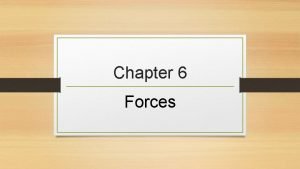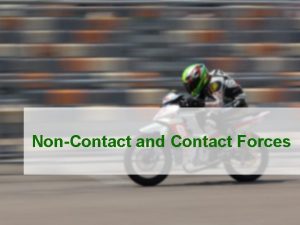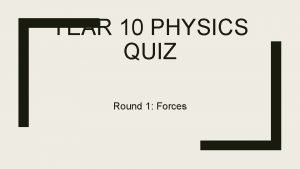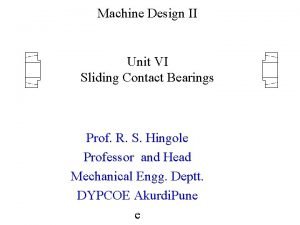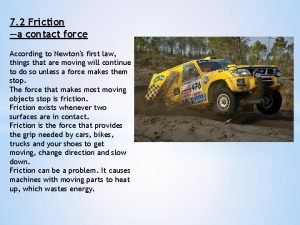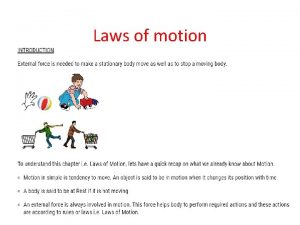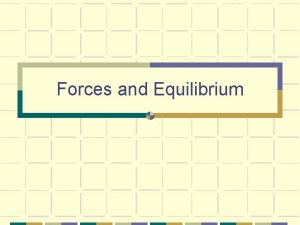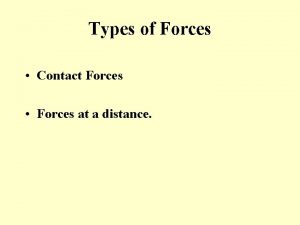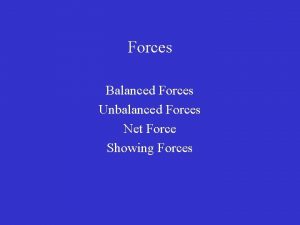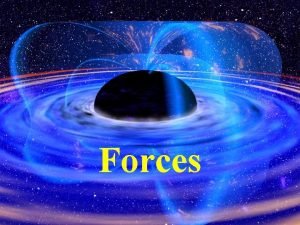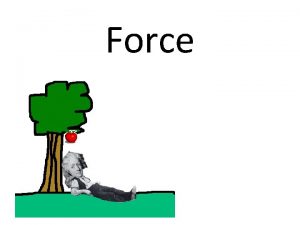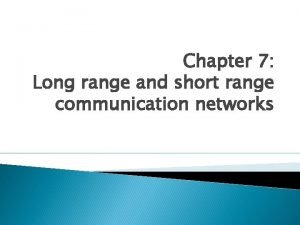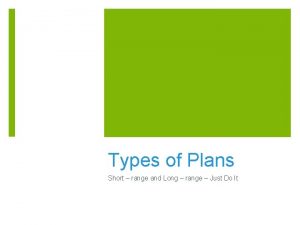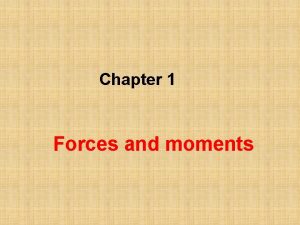Chapter 6 Forces Contact vs Long Range Force
































- Slides: 32

Chapter 6 Forces

Contact vs. Long Range Force • A contact force acts on an object only by touching it. Ex. You touching a book. Desk on the ground. • A long-range force is exerted without contact. Ex. Gravity. • Each force has a specific, identifiable, immediate cause called the agent.

Practice Problems • Do Practice Problems on page 119 of textbook. What forces are acting on each object?

Newton’s Second Law of Motion • How does an object move when one or more forces are exerted on it? • We will start by looking at motion horizontally and ignoring friction. • Look at figure 6 -2 a and 6 -2 b. Why is the velocity vs. time graph constant?

How does acceleration depend upon the force? • Based on the rubber band lab, we could plot the force exerted vs the acceleration of the cart. • We notice that the acceleration (a) is proportional with the force (F) exerted. • The larger the force, the greater the acceleration. • Linear relationship: F= ka ; k is the slope of the line.

How does acceleration depend upon the object? • What happens if the object changes? We put a second cart on top of the first. Then a third. • Look at figure 6 -3 b: What do you see? • The acceleration of 2 carts is ½ the acceleration of 1 cart. • So therefore, the slope of the lines depends upon the mass. More mass requires more force. • Mass is the slope: F=ma

Combining Forces • What if two or more rubber bands exert forces on a cart? In the same direction or in opposite directions? • We show the different forces acting on an object by using a free-body diagram. • Because forces are vectors, the total force on an object is the vector sum of all the forces exerted on the object.

Combining Forces Continued. . • The vector sum of two or more forces acting on an object is call the net force. • Experiments show that acceleration of an object is proportional to the net force exerted on the object and inversely proportional to the mass of the object being accelerated. • This is Newton’s 2 nd Law: a= Fnet/m or F=ma

Measuring Force: the Newton • Because force is equal to mass times acceleration, one force unit has the dimensions 1 kg x m/s^2. • The unit of force in the SI system is the newton, N.

Practice Problems • Do the Practice Problems on page 122. 2 -6.

Newton’s st 1 Law of Motion • “An object that is at rest will remain at rest or an object that is moving will continue to move in a straight line with constant speed, if and only if the net force acting on that object is zero. ” Newton’s 1 st Law of Motion • Often called the Law of Inertia: Inertia is the tendency of an object to resist change.

Newton’s 1 st Law of Motion Continued. . • If the net force on an object is zero, the object is in equilibrium. • Equilibrium happens when an object is at rest or is moving at a constant velocity. • Copy Table 6 -2 in your notes: Some Types of Forces.

Practice Problems • Do practice problems 7 -11 on page 124.

Common Misconceptions. . • Inertia is a force. Not true. • A force is needed to keep an object moving. Not true.

6. 2 Using Newton’s Laws • Newton formulated his laws over 300 years ago. • They still explain everyday motion!

Using Newton’s nd 2 Law • Aristotle believed that the heavier an object is the faster it falls. • Is this true? Why or Why not?

Mass and Weight • Galileo often used something called “thought experiments”. • Look at figure 6 -5. • A ball that is falling freely without air resistance has a weight that is equal to its mass times it acceleration.

Scales • Do scales measure mass or weight? • Look at figure 6 -6 b. • When you step on the scale, the scale exerts an upward force on you. • A spring scale measures weight not mass. • If you were on a different planet, the compression of the spring would be different, therefore your weight would change but not your mass.

Example and practice problems • Read through the example problems on page 128. • Then try Practice Problems 12 -13 on page 129.

Apparent Weight • Apparent weight is the force exerted by the scale. • Weightlessness does not mean your weight is zero. It means that there are no contact forces pushing up on you. Your apparent weight is zero.

The Friction Force • Static friction force is the force that is exerted on one surface by the other when there is no relative motion between the two surfaces. • The static friction force can only grow so large. Eventually the object will move. • The Kinetic Friction Force is the force exerted on one surface by the other when the surfaces are in relative motion.

Calculating friction forces • We assume that friction depends on the surfaces in contact, but not on the area of the surfaces nor the speed of their relative motion. • Kinetic Friction Force Ff, Kinetic = μk F N • μk is a proportionality constant called the kinetic coefficient of friction. • Static Friction Force • Copy table 6 -3

Continued. . • Example problems pg. 131 -132. • Do practice problems 14 -16 on page 133.

Air drag and terminal velocity • When an object moves through air or any other fluid, the fluid exerts a friction like force on the moving object. • This type of friction depends on the speed of the object. • Think about dropping a tennis ball from a tower. • The constant velocity that is reached when the drag force equals the force of gravity (no net force)

Terminal velocity • Terminal velocity can change and does change for different objects. • It depends on size and shape of the object.

Periodic Motion • Two quantities describe simple harmonic motion. • Period- the time needed to repeat one complete cycle of motion. • Amplitude- the maximum distance the object moves form equilibrium.

The pendulum • Look at the equation on page 135. Copy it into your notes and on your equation index card. • Notice that the period depends only upon the length of the pendulum and the acceleration due to gravity, not on the mass of the boob or the amplitude of oscillation.

6. 3 Interaction Forces • Interaction forces are the forces working in a system. • Think about when you thrown a baseball. • There are two forces: your hand on the ball and the ball on your hand. • What are the directions and magnitudes of these forces?

Newton’s Third Law • An interaction pair is the two forces that are in opposite directions and have equal magnitude. • So the magnitude of the force of your hand on the ball equals that of the ball on your hand. • Newton’s Third Law- states all forces come in pairs. Every action has an equal and opposite reaction.

Practice Problems • Practice problems on page 141.

Four Fundamental Forces • Find and share with class.

Forces of Ropes and Strings • Read and sumarize. Pg. 143
 Long range force
Long range force Which is a contact force? *
Which is a contact force? * Tension force contact or noncontact
Tension force contact or noncontact Contact and noncontact forces
Contact and noncontact forces Air resistance contact force
Air resistance contact force Examples of non contact force
Examples of non contact force Which of the following forces is a contact force? *
Which of the following forces is a contact force? * As compared to long-range forecasts, short-range forecasts
As compared to long-range forecasts, short-range forecasts Air resistance contact or noncontact force
Air resistance contact or noncontact force Tall + short h
Tall + short h Once upon a time there lived a boy
Once upon a time there lived a boy Sliding contact bearing
Sliding contact bearing Irritant contact dermatitis vs allergic contact dermatitis
Irritant contact dermatitis vs allergic contact dermatitis Dangling bond in fullerene
Dangling bond in fullerene Service marketing chapter 2
Service marketing chapter 2 Is drag a contact force
Is drag a contact force Is pressure a contact force
Is pressure a contact force Is air resistance a non contact force
Is air resistance a non contact force Is friction a contact force
Is friction a contact force Friction is a necessary evil
Friction is a necessary evil Why is gravity a non contact force
Why is gravity a non contact force Friction and air resistance
Friction and air resistance Tug of war or tug-of-war
Tug of war or tug-of-war Is upthrust a contact or noncontact force
Is upthrust a contact or noncontact force Buoyancy force contact or noncontact
Buoyancy force contact or noncontact Is drag a contact force
Is drag a contact force Find the resultant of two like parallel forces
Find the resultant of two like parallel forces The forces shown above are
The forces shown above are Intermolecular forces from strongest to weakest
Intermolecular forces from strongest to weakest Difference between intermolecular and intramolecular
Difference between intermolecular and intramolecular Inter vs intramolecular forces
Inter vs intramolecular forces Balanced forces and unbalanced forces venn diagram
Balanced forces and unbalanced forces venn diagram Is deposition constructive or destructive
Is deposition constructive or destructive
